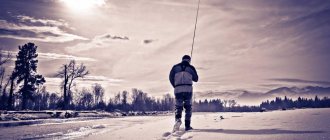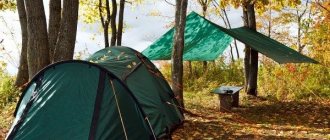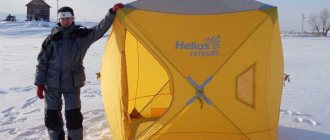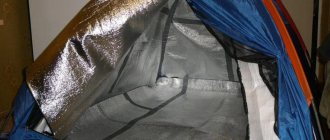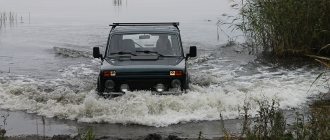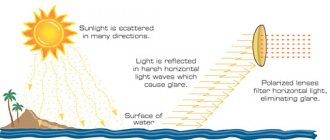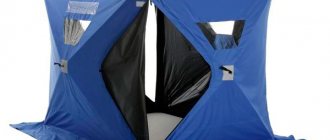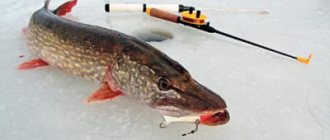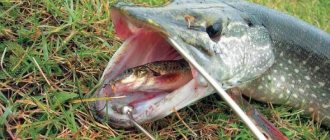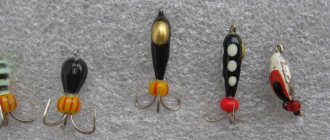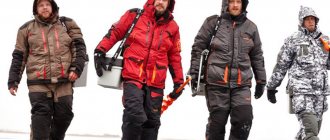Which tent to take for winter fishing? The first thing that comes to mind if you have never been on ice is the same one as usual! There are camping ones - larger ones, there is a lot of space. There are smaller tourist ones: they are not so comfortable. Reality with frost, wind, tanning guys and a natural draft from under the bottom of the tent usually puts everything in its place.
A non-specialized tent is not suitable for fishing. We will only spoil her if we go out on the ice with her. It is difficult to set up a large tent in the wind: smooth pegs will not be secured in the ice, and guys made of ordinary material (not reflective) will greatly interfere in the dark. It is more difficult to warm up a regular tent: the heat will simply be blown out by a stream of cold air from below.
The problem is that there are a lot of tents with “Winter” and “For Fishing” written on them in black camouflage. But not everything is a fisherman’s tent, one in winter camouflage or simply called a fishing tent. Let's figure out what to look for in a tent and what makes it winter and fishing friendly.
Table of contents
1. The shape of the tent for winter fishing is arc, umbrella or cube
2. Tent weight and dimensions
3. Select a winter fisherman’s tent based on the number of layers
4. Arcs made of plastic and arcs made of metal. The right tent is on the inner arcs
5. A good tent does not have a bottom, but even without one it can be difficult
6. Skirt, pockets and windows are mandatory and desirable elements of a tent
7. Automatic tents: what’s wrong with them
8. Portrait of an ideal tent from PIK-99
Advantages of an umbrella tent
After installation, many of the disadvantages described earlier already play into the hands of the user. Most manufacturers use durable materials for the frame , such as aluminum alloys B95 and D16, which makes it possible to increase the stability of the tent. Moreover, due to the strength of the frame, it is enough to use a smaller number of load-bearing parts, which will significantly increase the internal space . The height of some models can exceed two meters, and the area can be compared to the size of the hallway of an apartment. The interior space of the umbrella tent can be appreciated from the photo below. Such dimensions allow you to relax in nature with maximum comfort, even for a large group.
Umbrella tents usually have several entrances , ventilation or heating devices, wide windows, and a wide selection of additional accessories. You can attach a special sleeping module to some tents, install a wood or gas stove inside the tent, and assemble real labyrinths from a set of tent modules of this type.
The comfort of tents of this type is their main advantage, noted by most users. But, the higher the level of comfort, the higher the price of the product.
If we talk about a tent for winter fishing, the lack of a floor is more of a plus than a minus. After all, you need to make holes and have access to ice. The floor of the tent interferes with this process. True, experienced fishermen purchase a special insulated floor for a winter tent .
There is another interesting point. Surely everyone remembers about the so-called. convection _ This is a process of natural air mixing. Since the canopy of the umbrella is shaped like a cone, the warm air ends up lower in the tent than it would be in a cube-type tent. Accordingly, a fisherman or tourist has greater comfort inside the tent. This characteristic is rather vague, but according to subjective indicators it is often cited as an advantage of an umbrella tent.
1) Tent shape for winter fishing
There are four traditional forms of a winter tent. The main ones are a cube and an umbrella. Less common are arc tents and automatic models: the ones that unfold instantly and by themselves, but fold up... More on that later.
Arc tents: minimum weight and acceptable comfort
Small and lightweight arc tent
Not the most common type of tent for going out on the ice, but it is inexpensive and very light: a rare arc tent weighs more than 1 - 1.2 kg. It is easy to set up: like a regular tourist tent.
How long an arc tent will last depends on the material of the awning and the poles. The awning can be either waterproof or breathable. The last option is rare: mixed breathable fabric allows water to pass through too well. Tents with waterproof flysheets are the choice for late fall or early spring, when it rains almost more often than snow and temperatures are not as cold as in the depths of winter. Water resistance plays a cruel joke in cold weather: the tent breathes less well, so the “minus” inside is accompanied by high humidity. Being in it, and going out into the cold with wet clothes is not very pleasant.
Arcs can be made of Chinese fiberglass (it will not survive severe frost) or aluminum tubes. This frame turns out to be light and strong, but its price is higher.
Arc tents are chosen because they:
- are cheap;
- weigh little;
- easy to unfold. Especially in the hands of those who are used to summer tourist tents.
The disadvantages are the small useful volume (it is impossible to stand at full height in them) and restrictions on use.
Umbrella tent: quickly unfolds and does not notice the wind
Compact, lightweight and quickly deployable umbrella
The design of this type of tent is the same as that of a regular umbrella. They open easily - in 30 - 40 seconds - and assemble a little slower. It will take more time to straighten the awning (otherwise it may get jammed by the hinges of the folding mechanism) than to install it: when it’s dark, cold and windy, umbrellas are very convenient. If you need to change the location, no problem: the umbrella can be removed instantly. It is not necessary to fold it completely: just collapse it to make it easier to carry. They brought the umbrella to the new place and ten seconds later it was ready to receive guests.
The mechanism of the umbrella tent consists of a hub star and folding aluminum spokes. Hub (asterisk) - the central part into which the beams are mounted. Made of aluminum alloy: it is not afraid of cold, does not rust.
Umbrellas are available in 1-4-seater versions, single-layer or three-layer: in the umbrella segment, you can choose a model both for one-day trips to the ice and for fishing for the whole weekend.
Advantages of umbrella tents:
- quick assembly - in 30-40 seconds, plus the same amount of time to straighten the folds of the awning;
- light weight - even three-layer umbrellas (for example, STEC-UMBRELLA-4 ELITE for four people weighs 4.7 kg);
- wind resistance - the higher the number of spokes in the tent, so large four-person models with six spokes resist the wind much better than tiny single-person ones;
- on average, umbrellas are cheaper than cube tents;
- easy to warm up;
- quick and easy to carry.
The only disadvantage of umbrellas is their insufficient height and area. The umbrella mechanism eats up 10 cm of the “passport” height of the tent, and the rounded walls do not allow you to stand at full height around the perimeter. But the area of the umbrella tent is large: where you can’t stand, you can always place your equipment.
Winter cube tents: for long fishing trips
Tall, comfortable, spacious and warm cube
Cube tents are a solution for comfortable fishing; you can live in them for several days and store equipment. Therefore, if you are fishing not alone, but in a small group, choose a cube.
For large companies, tents KUB-3 three-layer DOUBLE or KUB-2 three-layer LONG are also suitable. The first is a kind of twin cube, two combined cubes. Its area is more than eight square meters. The second is an elongated cube with an area of almost 4 m².
The automation of a cube tent is an umbrella multiplied by five: that is how many semi-automatic umbrella mechanisms are used in the design of the cube. The shape of the hub of the cubes is complex; they are made of frost-resistant durable plastic. It takes longer to unfold it than an umbrella: it is inconvenient in strong winds. But the cube is tall - you can stand in it not only in the middle, but also closer to the walls. They are convex, so the habitability - the convenience of living and being in it - is better.
Among the cubes, you can choose either a lightweight single-layer tent or warm two- or three-layer ones. The type of fabric also changes from model to model - there are a lot of options to choose from. Cubes can have either a breathable roof or one made of waterproof fabric. The first is suitable for fishing in severe frosts, the second is suitable for going out on the ice in constantly changing weather conditions, as it will not get wet in rain or sleet.
The removable floor also adds comfort to the cube: it can cover at least part of the ice under the tent. On the route to the fishing spot, it is more convenient to carry a floor than a pack of foam, even rolled up into a tube.
To the table of contents>>
How to choose a tent for winter fishing
When choosing this equipment, you should pay special attention to the following characteristics:
- Dimensions. As a rule, the manufacturer provides a choice of two or one local models of this type of product. The undeniable advantages include light weight, which in turn allows you to travel with this gadget without resorting to any means of transport. The time-tested area is considered to be the size of one and a half square meters based on each fishing participant.
- Transport dimensions and weight of the product. It all depends on the cost and technologies used by the manufacturer, since a tent with a higher cost, as a rule, has more advanced material and, therefore, has less weight.
- Number of inlets. This is the main difference from a classic tent, which may have several entrances. The winter version may have only one entrance with a tight zipper to save heat inside the canopy.
- The presence of several layers of covering the tent frame. As a rule, the scope of application of this equipment plan is long fishing trips. They differ from their counterparts in increased ventilation and higher thermal insulation. The disadvantages include the rather high weight and high price of the product.
Characteristics that deserve special attention.
When choosing and purchasing, you should pay special attention to the following parameters:
- Wind protection level. The covering material must have good resistance to subzero temperatures and not be too rigid in its structure. Failure to comply with this parameter may result in damage to the fabric during folding into the transport position. Gusts of wind must not pass through the casing. Some manufacturers make special stripes that prevent snow from sticking.
- Providing air circulation. If there is no ventilation inside the tent, condensation will form intensively, which in turn will lead to frostbite on the surface. In order to avoid such troubles, manufacturers use either windows or special outlet openings. This parameter also plays a key role in heating the tent and removing carbon monoxide.
- Water resistance. This parameter is very important, despite its use in the winter season. It plays the main role in ensuring proper protection of the fisherman from wet snow or icy mixed rain.
- Execution of the frame. It is recommended to choose a frame made from various composite materials, as they are light in weight and high in strength. To save money, you can purchase arcs made of duralumin alloys.
2) Weight and dimensions of the tent
The packed size of a winter tent is impressive, especially when compared with tourist or small camping models: a packaged single-person tent is more than a meter long, while the “package” for a three-person tent is close to one and a half meters in length.
If the winter fishing tent looks too compact in the package, then the matter is dirty. Most likely you are looking at a cheap arc
or an automatic tent from the most budget ones.
You need to understand that when the manufacturer indicates the capacity of a tent, he means the comfortable placement of seated fishermen in it. You can only stand up to your full height in a four-person umbrella tent or a three-person cube. Therefore, you need to choose a tent according to the number of seats with a reserve.
Umbrella tents:
- if you fish alone, take a one- or two-person tent (its outer height is only 150 cm, and its inner height is about 140 cm);
- if you go together - a three-seater (height approximately 160 cm);
- A four-person, two-meter tent is enough for three people.
Cube tents are more convenient in terms of comfortable accommodation: a two-person model with a height of 175 cm is enough for two with a reserve, and a two-meter three-person model is enough for three.
The weight of good winter tents is not too different from tourist tents. Although winter tents only have an awning (there is no interior, like in a tourist tent), their frame is not made of tubes, but of rods. Single fisherman's tent STEC-ZONT-1D ELITE with breathable fabric
weighs 3.2 kg, and a double with reinforced awning fabric - 3.8 kg.
To the table of contents>>
3) Select a winter fisherman’s tent based on the number of layers
Even a good winter tent may only have one layer. And even the bad one is to “show off” three layers at once: with a membrane, impregnation and insulation. What is more important is not the number of layers, but what materials they are made of, how they are connected to each other, and how much a tent with one, two and three layers weighs.
Single-layer fishing tents
This can be a waterproof awning on a frame, or durable breathable fabric. The manufacturer usually indicates the water resistance of awnings in single-layer tents to be no more than 1 - 1.5 thousand mm - in practice it may be less. Although the awning is not designed for heavy rain for many hours, only for drizzle. In wet snow it will have to be cleaned periodically to prevent leaks. Well, it’s hard to breathe under a waterproof awning, especially for two people. Otherwise, “single-layer” tents are an inexpensive, good option for a tent for winter fishing. They weigh a little: not even the lightest single-layer tent Stack Elite 1 is only plus 3 - 3.2 kg to your luggage.
A single-layer tent may not be enough for comfortable fishing. The wind is too strong or the weather forecasters made a mistake - and now the tent cannot be warmed up or it begins to leak under the pressure of a mixture of wet snow and rain. Therefore, they cannot be classified as universal.
Single-layer tents with a reinforced waterproof awning are only suitable for warm winters. For frosty weather, a single-layer tent with a breathable roof is best. It is made of tarpaulin or mixed fabric and has good air permeability, so it is easy to breathe in the tent, even if you decide to light a burner for heating.
Why choose a single layer tent:
- low price. If you are not sure that you will devote more than one season to winter fishing, take a “single-layer”, it is cheap;
- light weight. If you are walking or alone, so as not to carry extra weight.
Double layer tents: windproof and free insulation
In double-layer tents, an inner tent is added to the awning (it protects from precipitation). Its fabric is Greta, a cotton-blend material: it allows steam to pass through (breathes), so it is comfortable to be in the tent. Due to this, the design provides better protection from the wind. Double-layer tents also have insulation, which you get for free - this is the air between the awning and the inner layer.
Double-layer cube tent: both breathes and warms
There is no problem of condensation in two-layer tents: the inside breathes and allows moisture to pass out, where it freezes on the tent. But there is a weight problem: if the tents are the same size and shape, then a two-layer one will weigh more than a three-layer one.
Why choose double-layer tents for winter fishing:
- this is a balanced tent - it is warm, does not accumulate condensation and keeps out the wind;
- mixed fabric of the inner tent - sometimes it’s just nice that there’s more than just synthetics around;
- Due to the breathability of the roof and the inner tent, it is cozy in the cold - moisture accumulates less inside the tent, so even a serious disadvantage is easier to bear.
Three-layer tents: a winter house for a fisherman
Lightweight, compared to double-layer ones, these tents are quite suitable for the role of a winter house for 2 - 4 days of fishing. They are warmer than double-layer tents, are not afraid of condensation, and hold the wind well. Three-layer tents are insulated with padding polyester. The design is made of waterproof awning, padding polyester and lining - everything is like a normal winter jacket.
Why three-layer tents are chosen for winter fishing:
- light weight - a three-layer umbrella for two people weighs only 4.7 kg;
- universal - you can live and fish in a tent both in slight minus and in severe frosts;
- no condensation inside;
- They warm up quickly and do not lose heat - thanks to a layer of thermal insulation and a wide skirt around the perimeter of the tent.
To the table of contents>>
Advantages of umbrella tents
The frame is made of durable materials, which increases the stability of the tent and its reliability. Since the structure has increased strength, fewer load-bearing parts can be used, which increases the free area. Winter tents for fishing and umbrellas can reach a height of 2 m and have a fairly large area. The large dimensions of some models can accommodate several people.
A winter umbrella tent has one entrance, it has devices for ventilation and heating, large windows, and many auxiliary parts. Some models are equipped with a sleeping module and a gas stove is placed inside. The main advantage of umbrella-type tents is their high level of comfort. The lack of a floor is an advantage for ice fishing because the fisherman needs to have access to ice to drill a hole.
If desired, you can separately buy a waterproof insulated floor and fishing chairs.
Design Features
The design of the product is based on the use of a mechanism with spokes, operating like an umbrella. The frame and awning are a single whole, which makes it possible to install all elements simultaneously. This simplifies the installation of the tent: you just need to straighten the spokes of the frame and pull the mechanism handle down from the inside.
Strong gusty winds can complicate the installation of the structure, so you need to wait until it subsides and then unfold the product. You should be prepared for the fact that physical force must be applied to open the mechanism.
4) Plastic arcs and metal arcs
The vast majority of winter tents have an internal frame. This is safer and more convenient: the awning and other layers (insulation, lining) are laid out along with the frame. If you see a winter tent with an external frame, it is most likely cheap and made somewhere in the hot jungles of southern China.
The advantage of such tents is their very low price. But they are enough for one season. You definitely won’t like laying them out in the cold: as a rule, the plastic on such tents does not tolerate low temperatures well, it cracks, and the installation process is drawn out, because first you need to secure the poles and then hang the awning from them. Most likely, at the beginning of spring your tent will appear as a lot on Avito.
Theoretically, the performance characteristics of a tent should not depend on the location of the frame: inside or outside. But it is what it is: cheap tents with an external frame are worse, while more expensive and technologically advanced models with an internal frame are more convenient.
The same can be said about tents whose poles are made of Chinese fiberglass: the material does not withstand frost and cracks.
This is what fiberglass looks like. If your frame from a Chinese tent is broken, you can buy sections for repair from us
A good winter tent has a frame made of domestic reinforced fiberglass or aluminum-based alloys. Fiberglass is a type of fiberglass. But the domestic one is of higher quality and thicker, and the reinforcement makes it more resistant to bending loads - which are inevitable when setting up a tent in the wind.
Fiberglass with carbon tolerates severe frosts well, is flexible and resilient, and weighs little
Aluminum alloys B-95 or 7075 are even stronger than composites with carbon - it is springy and does not bend. The most wind-resistant tents are made with an aluminum rod frame.
To the table of contents>>
Storage and transportation
For most of the year, the folded tent is in a state of long-term storage. At this time, it may be affected by negative factors, such as dampness, deformation, and aggressive environmental influences.
Therefore, you should follow the rules for storing a tent. The product must be stored dry; if it was difficult to dry the tent at the fishing site, then this must be done after the angler has returned home. If the product remains wet, the water accumulated on the fabric will begin to bloom and the material will become moldy.
In addition, the inner lining is coated with water-repellent impregnation, which is water-soluble in composition. If moisture remains on the fabric, this coating will gradually deteriorate. After deformation of the protective layer, the surface of the tent will begin to let water through. When exposed to moisture, materials will become more brittle and the cladding will crack at the most inopportune moment.
The product must be stored on a flat surface; there should not be any load on it, as this can lead to breakage of the bag and the folded tent. There are arches inside the tent; they are considered the most fragile part of the structure. If the arc bends, it may break, and the material under load will crack at the seams.
Also, under no circumstances should pegs or other foreign objects be wrapped in the product; they can damage the skin, and then the winter tent repair process will be required. Repaired products do not have sufficient strength and may soon become unusable.
It is necessary to pay attention to those items that are stored next to the tent. For example, there may be caustic solvents or other chemicals in the garage or mezzanine. These chemicals can burn right through the fabric and destroy the waterproof surface.
5) A good tent does not have a bottom, but even without it it can be difficult
Almost all winter fishing tents are sold without a bottom. This is more convenient, because it is not known how many holes will have to be drilled in the tent, and for this you will have to either bend the bottom or remove it altogether. Also, if the tent does not have a bottom, it weighs a little less: you won’t have to drag another kilogram of dense material.
The bottom of the tent: it can be bent or removed altogether if you need to drill a lot of holes
To be fair, bases for winter fishing tents are still sold - after all, with a bottom it is warmer and more comfortable. If you don't plan to spend several days in a tent, just take a camping mat with you.
To the table of contents>>
6) Skirt, pockets and windows are mandatory and desirable elements of a tent
A skirt is an essential element of a tent for winter fishing. How well the tent will hold up to wind and snow depends on its geometry and size. In the best models, the skirt is wide and solid - it’s much warmer. Just good quality winter tents can have a short skirt with slits: the places where the skirt wedges do not overlap each other should be sprinkled with snow.
If the tent does not have pockets, you will have to place small items at the bottom or directly on the ice, with the risk of losing them, trampling them, or even drowning them. Any good tent should have pockets. And better are the classic ones, sewn onto the awning or inner layer of the tent. Hanging pockets are more convenient only at first glance: they make it difficult to move around the tent.
It would be great if every tent had windows. But this complicates the design and makes the tent more expensive. The window - no matter whether it is sewn or glued into the awning - is the weak point of the structure and will be the first to break. Therefore, it is better to buy a tent without windows: even if you add a powerful camping lantern to your purchase, it will be cheaper.
To the table of contents>>
Reviews
Several years ago I once purchased a tent from the Lotus company. I can’t say anything bad, although I didn’t use it fully, I only came in occasionally to warm up (for 5-10 minutes), which was enough for me. The main thing is that it seemed to me quite transportable and roomy. Grade:
Oleg, 34 years old (St. Petersburg)
I am very pleased with my recent purchase - a tent from the Penguin 3 (Arctic) series. Very warm, just like I wanted. My wife and little son often travel with me. They do not complain about the cold and did not freeze at night. I don't regret the money spent! Thank you! Grade:
Sergey, 27 years old (Rostov-on-Don)
For a long time I thought about finally buying a tent, because I am often hostage to bad weather during winter fishing. The STEK model tent is very comfortable, keeps heat and is stable even in strong winds. 7000 was not wasted. Now I can go fishing in any weather. Thanks to the manufacturers! Grade:
Evgeniy, 51 years old (Omsk)
FisingHOT CUBE 3 is a fairly roomy and easy to install tent - this is a definite plus. But there are disadvantages: in strong winds the structure can collapse, which is very bad. I recommend this same manufacturer to everyone (a quality product), but if you buy it, it will be an umbrella type, not a cube. Grade:
Arseny, 38 years old (Chelyabinsk)
My wife gave me a Lotus 5 tent three years ago, especially for winter fishing. I was grateful for the gift, since constantly warming myself in the car in hot weather is not an option. The reviews and characteristics have justified themselves: a reliable, durable and heat-retaining design. Grade:
Andrey, 43 years old (Voronezh)
7) Automatic tents: what’s wrong with them
A modest automatic tent: it is unknown how the folding mechanism will behave in severe frost. And even if it gets snowed in...
Lightweight, weighing from 2 to 3 kg, and even unfolds in seconds - what could be wrong with an automatic tent? “What’s wrong” may be with the mechanism itself: how long it will work and how it will behave in severe frost cannot be predicted. But the price of self-folding tents is significantly less than semi-automatic umbrellas and cubes.
The package is flat and round, like a tambourine, with a diameter of up to 70 cm - it won’t fit in a tourist backpack, only in a wide one, like a “dacha resident / kolobok”.
To the table of contents>>
Portrait of a tent for winter fishing from PIK-99
We figured out what criteria you should use to choose a tent for going out on the ice. We found out what the difference is between cube tents and umbrellas, arc tents and automatic ones. It's time to choose.
For severe frosts and hurricane winds - three-layer umbrella tents from the ELITE series. This is a waterproof awning, a breathable roof, a wide one-piece skirt to protect against blowing, a strong aluminum frame and an indestructible metal hub sprocket. With such a tent you can safely go winter fishing either alone or with a group.
If it is not clear what will happen to the weather in a couple of hours, or you plan to go fishing for at least two or three days, a two-layer cube tent will be comfortable not only for fishing, but also for simply living.
Severe frosts are not expected, but will you have to deliver the equipment yourself? Then choose lightweight single-layer cubes and umbrellas.
All tents in the PIK-99 store are checked before sale - there are no defective products among them. Thanks to the inspection, you can also save money: tents with minor defects are sold at a discount. Well, if defects do not allow the tent to be used normally, it becomes a source of spare parts for those that have been in service for more than one year and need the attention of the owner. Tents are not checked selectively, but without exception: if a tent does not fall into the discounted category, it means it has been installed, folded and inspected several times.
To the table of contents>>
The best expensive tents for ice fishing
Here are some options for expensive tents for ice fishing:
- Tramp Ice fisher 180. It has a cube shape and is made of two layers of polyester fabric, which makes the tent resistant to wind and moisture. It is designed for three people. Has one entrance, viewing windows and ventilation holes. The door can be secured with Velcro when open. The bottom is reinforced with a snow “skirt”. This tent also has reflective elements.
- Maverick ICE 5. Has a hexagon shape. It is also made of polyester, which is absolutely windproof and does not bend under strong gusts of wind. This is also achieved thanks to the metal frame. Double tent. It has wind braces, a reinforced bottom on the outside and semicircular windows that also serve as ventilation holes.
- Trump Wild. The shape resembles a hemisphere. This tent is warm because it has two layers. The top layer is impregnated with a special water-repellent composition. The second layer is made of fine mesh, which allows the fabric to breathe and avoid condensation inside the tent. The tent also has ventilation holes, which, in the absence of wind, can also be used as windows.
Maverick ICE 5 (average cost RUB 9,000)
Tramp Wild (average cost RUB 10,500)
Tramp Ice fisher 180 (average cost RUB 12,500)
9) What else might you need?
We have collected products that will be useful in addition to a fisherman's tent:
- screws - you can’t drive an ordinary peg into the ice, so you need a special one, in the form of a tube with an external thread and handles for screwing in;
- gas heater - a manual heater will help warm the tent even in severe frost and spend the day and night in comfort;
- spare parts - if the frame, awning, cover or sprocket of the umbrella mechanism is damaged, you can buy a replacement part from us;
- reflective ropes - winter days are short, and reflective ropes are clearly visible in the light of a flashlight and the moon, so you won’t stumble;
- lanterns for tents, head and hand-held - will illuminate the road, tent and fishing area in the dark winter;
- floor for the cube - it makes the tent warmer and more comfortable. The cold doesn't come from ice. And the snow does not melt inside the tent when it is heated to above-zero temperatures;
- Thick foam mats are a universal thing for winter and summer.
To the table of contents>>
